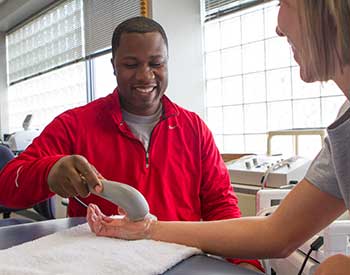The PTA and the Physical Therapy Profession:
There are two types of physical therapy practitioner: the Physical Therapist (PT) and the Physical Therapist Assistant (PTA). Physical therapists (PTs) and physical therapist assistants (PTAs) are an important part of the health care team and provide quality care to nearly 1,000,000 patients per day across the United States. Physical Therapist Assistants are health care professionals who work under the direction and supervision of a Physical Therapist. Physical Therapist Assistants perform physical therapy procedures such as heat and cold treatments, electrical stimulation, therapeutic exercise, and gait training; and other related task delegated by the Physical Therapist. The procedures and techniques are designed to improve a client's movement, musculoskeletal function, and to relieve pain or increase strength.
PTAs help people of all ages who have medical problems, or other health-related conditions that limit their ability, to move and perform functional activities in their daily lives. Care provided by a PTA may include teaching patients/clients exercise for mobility, strength and coordination, training for activities such as walking with crutches, canes, or walkers, massage, and the use of physical agents and electrotherapy such as ultrasound and electrical stimulation. Today, physical therapist assistants provide health care services to patients of all ages and health conditions in a variety of settings, including:
 Outpatient clinics or offices
Outpatient clinics or offices- Hospitals
- Inpatient rehabilitation facilities
- Skilled nursing, extended care, or subacute facilities
- Homes
- Education or research centers
- Schools
- Hospices
- Industrial, workplace, or other occupational environments
- Fitness centers and sports training facilities
PTAs must complete a 2-year associate degree program and are licensed, certified, or registered in most states. States requiring licensure, such as Tennessee, stipulate the specific educational and examination criteria.
According to the Bureau of Labor Statistics, employment is expected to grow much faster than average because of the increasing demand for physical therapy services. Employment for physical therapist assistants is projected to grow “much faster than average” over the next decade (U.S. Department of Labor). The BLS listed PTA job growth to be "much faster than average" for 2018 - 2028.
Further information about the physical therapist assistant profession can be found at www.apta.org.
Bureau of Labor Statistics, U.S. Department of Labor, Occupational Outlook Handbook, 2019 - 2020 Edition, Physical Therapist Assistants and Aides.

